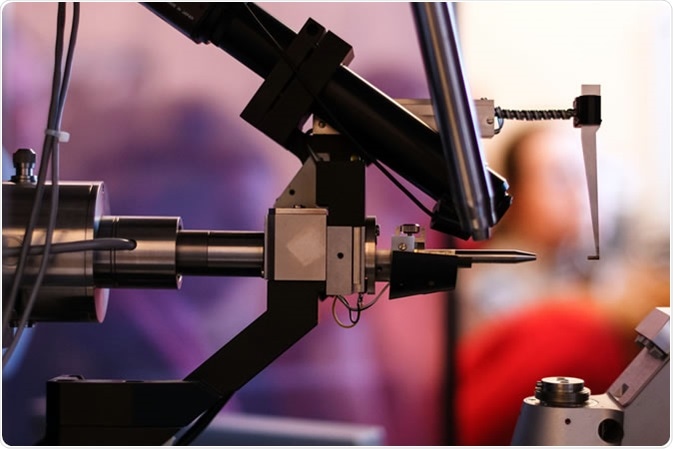Skip to:

X-Ray crystallography scientific equipment. Image Credit: Gregory A. Pozhvanov / Shutterstock
Drug development relies on having an accurate knowledge of the structure of organic molecules such as proteins, nucleic acids, and viruses. The field is a multi-billion-dollar industry, and the need for new, novel drugs means that scientists working in the industry need to be able to use the best-placed methods to develop them.
Ever since its discovery over a century ago, X-ray crystallography has been one of the most widely used and useful structural analysis tools that is available to researchers. One of the early structures important to drug development that was resolved by this method was insulin. Until recently, however, it has been mostly restricted to lead development due to factors such as time constraints. Using it in combination with contemporary technological developments, X-ray crystallography is now moving beyond these traditional constraints.
Structural Information and Its Use in Structure-Based Drug Discovery
Structure-based drug discovery involves the use of structural information in drug development. Data obtained from the three-dimensional structures of biological macromolecules (especially those determined by X-ray crystallography) are considered the ‘gold standard’ for describing the molecular architecture of important proteins and nucleic acids. Drug development efforts that utilize CADD (computer-aided drug design) can use the information that is yielded from macromolecular models.
There has also been an increase in macromolecular models available for research in recent years. The Protein Data Bank (PDB), which was formed in 1971, has seen an exponential rise in structural data submitted to it over the years, and now stands at over 100,000 entries, with nearly 90% having come from X-ray crystallographic studies. This is one of the premier resources for any researcher in the field of drug discovery, and crystallographic data on the three-dimensional structure of proteins and macromolecules has played a particularly important role in its development.
Some Important Molecules for Drug Development Revealed by X-ray Crystallographic Studies
Over the past two decades, there has been an unprecedented success in the development of drugs that are highly potent and selective, as well as useful lead compounds. Information obtained from crystal structures of target protein macromolecules have played a large part in this. Most notably, crystallographic studies have determined the structure of inhibitors of HIV protease.
Recently, other proteins that are of relevance for drug development that have been determined with crystallographic studies include inhibitors for influenza virus neuraminidase, and crystallography has been used to determine the structure of Flavivirus NS2B-NS3 protease, which is essential for virus replication. As flaviviruses (which include Zika and West Nile) have no known effective cure or treatment, they are especially challenging to researchers keen to develop drugs to combat them.
Using crystallographic information, the team of researchers managed to yield a series of drug-like Flavivirus protease inhibitors that exhibited antiviral properties, both in cells and in mouse models of Zika virus.
With each structure that is revealed through the application of X-ray crystallography, drug development scientists can gain useful insights that make targeted treatments, and possibly cures, closer to fruition.
Is X-ray Crystallographic Data Reliable on Its Own?
However, X-ray crystallography on its own, like all analytical methods, does have some drawbacks, and therefore must be used in conjunction with other methodologies and technologies. Sometimes, crystallographic data may mislead drug discovery. Especially when using structures that have been deposited in the PDB, it must be remembered that some of these may be of poor quality. Therefore, these must be excluded.
There can also be bias in interpretation of the macromolecular structure from the electron density map, and bias can also be introduced by the resolution of phases in the diffraction data. However, this should not discount the use of crystallographic data as the method still presents the most reliable way to gain unique insights into the three-dimensional structure of target proteins.
Further to the problems with a small subset of publicly available structural information, privately held structural data can also present problems, as the quality can be difficult to ascertain due to its restricted nature. As drug development relies on both private and public structural information, it is easy to see how this is an issue.
As has been pointed out, X-ray crystallography can only be used as part of a suite of tools and methods. To achieve desirable results and the development of more promising compounds, structural, functional, and bioinformatics data must be utilized if methods of action are to be understood better. It would be easy to disregard experiments with contradictory results, but these should instead be carefully analyzed before they are deemed irrelevant.
Finally, as much raw data as possible must be retained, as this can clarify contradictory results and/or disputable interpretations. Big Data paradigms are especially useful here.
The Future of X-ray Crystallography in Drug Development
X-ray crystallography on its own only supplies part of the solution, and as such its potential as an application for structure-based drug development is limited. Future challenges lie in fields such as data validation, mining, and management. Big Data paradigms are required for the processing of structural information, which must be combined with functional, experimental, and bioinformatics data. As new technologies are developed and current ones refined, X-ray crystallography will continue to play an important part in pharmaceutical drug development.
What is X-ray Diffraction?
Sources
- Zheng, H et al. (2014) The future of crystallography in drug discovery, Expert Opin Drug Discov. 2014 Feb; 9(2): 125–137. https://www.ncbi.nlm.nih.gov/pmc/articles/PMC4106240/
- Zheng, H et. al (2015), X-ray crystallography over the past decade for novel drug discovery – where are we heading next? Expert Opinion on Drug Discovery, Volume 10, Issue 9 www.tandfonline.com/.../17460441.2015.1061991
- Blundell, T.L, Patel. S (2004), High-throughput X-ray crystallography for drug discovery, Current Opinion in Pharmacology, Vol. 4 Issue 5 pages 490-496 https://www.sciencedirect.com/science/article/pii/S1471489204001225
- Yuan Yao et al.(2019), Discovery, X-ray Crystallography and Antiviral Activity of Allosteric Inhibitors of Flavivirus NS2B-NS3 Protease, J. Am. Chem. Soc. 2019 141176832-6836 https://pubs.acs.org/doi/abs/10.1021/jacs.9b02505
- RSCB PDB: Homepage www.rcsb.org/
Further Reading